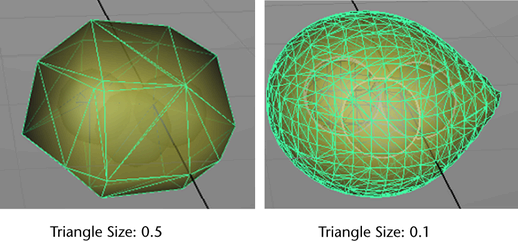Using the Output
Mesh attributes, you can set the resolution and quality
of your nParticle output meshes.
See
nParticle output meshes.
To set nParticle Output
Mesh properties
- In the scene view, select the nParticle
object that’s been converted to a polygon mesh.
- In the Attribute Editor,
select the nParticleShape tab.
- In the Output Mesh section
do the following:
- Set Threshold to
control surface blending between the Blobby Surface nParticles.
See
Set Threshold.
- Set the Blobby Radius Scale to
specify the amount the nParticle Radius is scaled
to create a smooth surface on Blobby Surface nParticles. See
Blobby Radius Scale.
- Set Motion Streak to
elongate the nParticles that create the mesh. See
Motion Streak.
- Set the Mesh Triangle Size to
specify the size of the polygon triangles that are used to create
the nParticle output mesh.
Smaller Triangle
Size polygons produce smoother meshes, but take more time
to simulate.
See
Mesh Triangle Size.
- Set the Max Triangle Resolution to
specify the maximum resolution of the grid used to generate the
output mesh triangles.
If the grid size required
to create an nParticle mesh exceeds the Max Triangle Resolution value,
the output Mesh Triangle Size automatically increases
to compensate for increasing size of the nParticle mesh. See
Max Triangle Resolution.
- Turn on Use Gradient Normals to
make the normals on an nParticle output mesh more smooth. See
Use Gradient Normals.
- From the Mesh Method list,
select the method you to use to generate the nParticle output mesh.
See
Mesh Method.
- Set the Mesh Smoothing Iterations to
specify the amount of smoothing you want apply to the nParticle
output mesh. See
Mesh Smoothing Iterations.
- To generate per-vertex shading data,
do the following:
See also
Output mesh per-vertex shading.
- To generate per-vertex velocity data
for motion blur, turn on Velocity Per Vertex.
See
Create motion blur and
Velocity Per Vertex.
- To generate a UVW coordinate system for
your mesh, turn on Uvw Per Vertex.
You can use the UVW coordinate
system to assign textures to your output mesh. See
Uvw Per Vertex.
